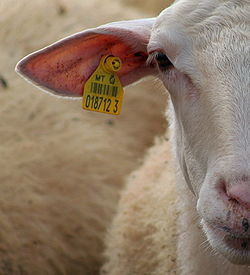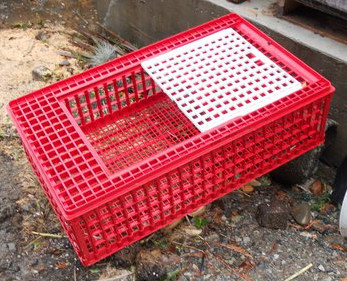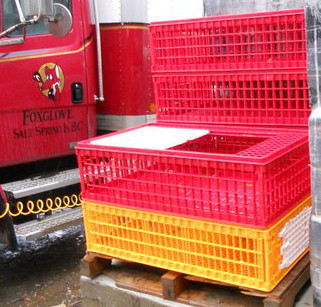There will be an open house at the abattoir from 1-5 pm Friday April 12th.
Please come and visit us at 1447B Fulford Ganges Rd – Come and see how your donations have been spent and what is still left to do!
There will be an open house at the abattoir from 1-5 pm Friday April 12th.
Please come and visit us at 1447B Fulford Ganges Rd – Come and see how your donations have been spent and what is still left to do!
 On your own farm tags may be irrelevant. You know your sheep by their faces, voices, wool colour, behaviour or possibly by the shape of their horns. After slaughter all these outward signs and behavioural clues are absent.
On your own farm tags may be irrelevant. You know your sheep by their faces, voices, wool colour, behaviour or possibly by the shape of their horns. After slaughter all these outward signs and behavioural clues are absent.
Abattoirs identify carcasses, and at a later stage packages of meat, by owner name and sheep tag number. This makes it possible for all meat to be traced back to the farm of origin and to a specific animal. This is what traceability means.
This only works if all sheep arrive at the abattoir with tags IN THEIR EARS, not in their owner’s hand or pocket. Identification of all animals that leave their birth farm for any reason has been required for a number of years. Tags can be ordered from Canadian Co-op Wool Growers in Lethbridge by phoning 1 800-567-3693. Your name and the tag numbers issued to you are kept on record. The tags are intended for use on your farm only. If you “borrow” tags from another farm this means that in the case of a suspected meat quality problem your sheep will be identified as coming from somebody else’s farm. This is a sure way to lose friends.
Sheep arriving at the abattoir untagged will not be unloaded because they cannot be processed without individual identification. If you have bought tags and would like help putting them in please write a message to the abattoir by clicking Contact and we will find someone to help you learn how to do it.
The Salt Spring Abattoir will be able to slaughter, cut and wrap lamb starting on February 27th. To request a booking for sheep or goats please use the online booking form at saltspringabattoir.ca. Until the form is revised to cover red meat please use the poultry booking form and give details of your request in the message box at the end of the form.
The abattoir now has its licence for red meat slaughter, and expects that within days it will receive approval for cutting and wrapping. We will then be able to accept bookings for lambs as well as poultry. The first 6 local lambs were processed on January 31st.
Members of the Abattoir Society will have priority when booking. To join please click here.
To make a booking request please click here. Booking dates will be posted on the calendar in April for the rest of the year.
Several kinds of meat chicken are regularly grown on Salt Spring. Until three years ago almost all were the white Cornish crosses. These are usually grown for 8 or 9 weeks, and have a large amount of breast meat and short legs.
Then two new kinds were brought in as chicks by air from Pennsylvania, the Redbro and the Mistral Gris. Both are bred from four different grandparent stocks (this means that they are a 4 way cross, not a breed) and both are now available in western Canada.
This means that it is far easier and possibly a little cheaper to obtain the chicks, and there will be much more flexibility in the hatching season, meaning that chicken will be available for purchase throughout the growing season instead of coming all at once in July and October.
The Redbro and Mistral Gris are both called “rustic broilers” and are ready at about 11 weeks. They are of different ancestry than the Cornish cross and also live several weeks longer, so can be expected to taste a little different. Flavour increases with the age of the bird.
The Redbro has mostly red feathers and is a taller bird with longer legs than the Cornish cross. This means that it has more dark meat. Males and females are not much different in size at 11 weeks.
The Mistral Gris is black and white and resembles a Barred Rock chicken in build and colour. There is more size difference between the genders than with the Redbro. They also are ready at 11 weeks.
When new feathers first come through the skin after a moult they are sharp and bristly and difficult to grasp. These are called pin feathers. Plucking machines cannot remove them. As they grow longer they open out at the tip and look like small paintbrushes. Eventually the feathers lengthen and fluff out and look normal.
Loss of feathers (moulting) and replacement with new ones occurs at regular intervals. Textbooks will tell you when this is expected to occur, so that you can plan slaughter when there are no pin feathers present. However this is not an exact science.
Moulting is somewhat unpredictable, being influenced by breed, age, temperature, light levels and feed. Therefore you need to be able to recognize when your birds SHOULD NOT be sent for slaughter because it is impossible to do a good job of plucking.
Before loading birds for transport run your hand up the breast and if it feels bristly that bird should stay home. If the breast is smooth we can produce a clean carcass.
The abattoir has now processed many small groups of roosters. All were intended for
food, but depending on their age they may need to be cooked in different ways.
Most of these birds are of mixed breed, so were not grown specifically to become meat.
Some may have been the roosters from laying breeds, so they are long and lean with very
little breast meat, but muscular thighs. The texture of the meat from these relatively slow
growing birds will be finer grained and firmer than the very young meat chickens, but if
appropriately cooked will not be tough.
Chickens up to the age of a year do not need special treatment, but should be kept moist
during cooking as the meat layer is thin and there is very little body fat. Older birds
benefit from longer slower cooking. Stewing in the oven, or cooking in a crockpot whole
or cut up, will make the most of this kind of meat, regardless of age.
The old Scottish favourite, Cock-a-leekie, is a sure way to produce a tasty meal from
your surplus mature roosters. Be sure to choose a recipe that simmers the meat and bones
for several hours.
Pastured chicken is raised out of doors on grass, in contrast to most commercial chicken which is raised indoors in large barns.
“Chicken tractors” are mobile pens that can be pulled onto fresh grass every day or two. They were invented to provide a clean safe environment for the young chickens, where they could live from about 4 weeks old, when they no longer need lights, until ready for harvesting. This gives them access to clean grass and weeds, while provided with feed, water, shade and predator protection.
Pen designs vary tremendously. Most will hold 50 to 70 chickens, and are moved either with a tractor or for the lighter ones by human effort only. Many designs are available on
the internet and many have been built here. Wood is most popular material, but plastic pipe, tarps, and plastic or wire netting have been used. Some have automatic watering systems.
This system provides a safe controlled environment and easy observation of the flock for the owner. It also fertilizes the ground they occupy, leaving a bright green trail where the pens used to be. This management system was made famous by Joel Salatin, who has written books about it and inspired local farmers on his recent visits to BC.
Please click on any image to see a larger version:
Poultry processing will resume in March. Dates will be set when requests for service are received. Abattoir Society members will receive advance notice of the dates available.
Red meat processing will begin as soon as the remaining equipment, now on order, has been installed and the licence issued. This might be as soon as late January, but cannot be guaranteed. Booking off island is recommended if you need immediate slaughter service.
Since September 28th 2012 the abattoir has processed 1239 chickens, 266 turkeys and several dozen ducks and geese from 45 poultry growers, providing part time employment for seven workers.
Happy New Year to all our clients and supporters!
Meat chickens take many weeks to grow, and much time and effort to keep them healthy until the day they become food. Mistakes on that last day can reduce meat quality and value.
Chickens can be damaged by rough handling when picked up for loading, by being pushed into boxes with an opening that is too small, or by being crowded so that they trample and suffocate each other, or peck each other until they draw blood. All this can be prevented if transport methods are appropriate for the size of the birds.
 Plastic chicken crates with a sliding door near the middle of the top are lightweight, easy to clean, well ventilated and available for rent or purchase from Foxglove Farm and Garden Supplies. They can easily be stacked, and can help you count your chickens if you always load the same number to a crate. Many people have made their own wooden boxes that have all these features, but they are usually larger and heavier than the plastic ones and are not as easy to clean.
Plastic chicken crates with a sliding door near the middle of the top are lightweight, easy to clean, well ventilated and available for rent or purchase from Foxglove Farm and Garden Supplies. They can easily be stacked, and can help you count your chickens if you always load the same number to a crate. Many people have made their own wooden boxes that have all these features, but they are usually larger and heavier than the plastic ones and are not as easy to clean.
 Some of the chickens received at the abattoir have been in tiptop health, clean and gently handled, with every one in a large batch arriving safely and passing inspection. Others have had an uncomfortable last day, exposed to wind and rain en route and looking very bedraggled and muddy on arrival. Many cages have broken fastenings or an opening that is impossible for one person to operate. Judging by the volume of droppings in the cages it is clear that some owners forget to remove feed on the last day. The abattoir has a covered area for chicken crates but not for trailers or pickup loads, so it is up to you to provide adequate shelter on the road and for the short wait after arrival if you are not using crates. Chicken size may also affect meat quality as very big chickens are too large for the chicken cones and too small for the turkey ones, so are much more difficult to slaughter without damage. The same applies to turkeys too large for the extra large turkey cone, which is why the abattoir staff prefer turkeys that weigh less than 30 lbs live.
Some of the chickens received at the abattoir have been in tiptop health, clean and gently handled, with every one in a large batch arriving safely and passing inspection. Others have had an uncomfortable last day, exposed to wind and rain en route and looking very bedraggled and muddy on arrival. Many cages have broken fastenings or an opening that is impossible for one person to operate. Judging by the volume of droppings in the cages it is clear that some owners forget to remove feed on the last day. The abattoir has a covered area for chicken crates but not for trailers or pickup loads, so it is up to you to provide adequate shelter on the road and for the short wait after arrival if you are not using crates. Chicken size may also affect meat quality as very big chickens are too large for the chicken cones and too small for the turkey ones, so are much more difficult to slaughter without damage. The same applies to turkeys too large for the extra large turkey cone, which is why the abattoir staff prefer turkeys that weigh less than 30 lbs live.